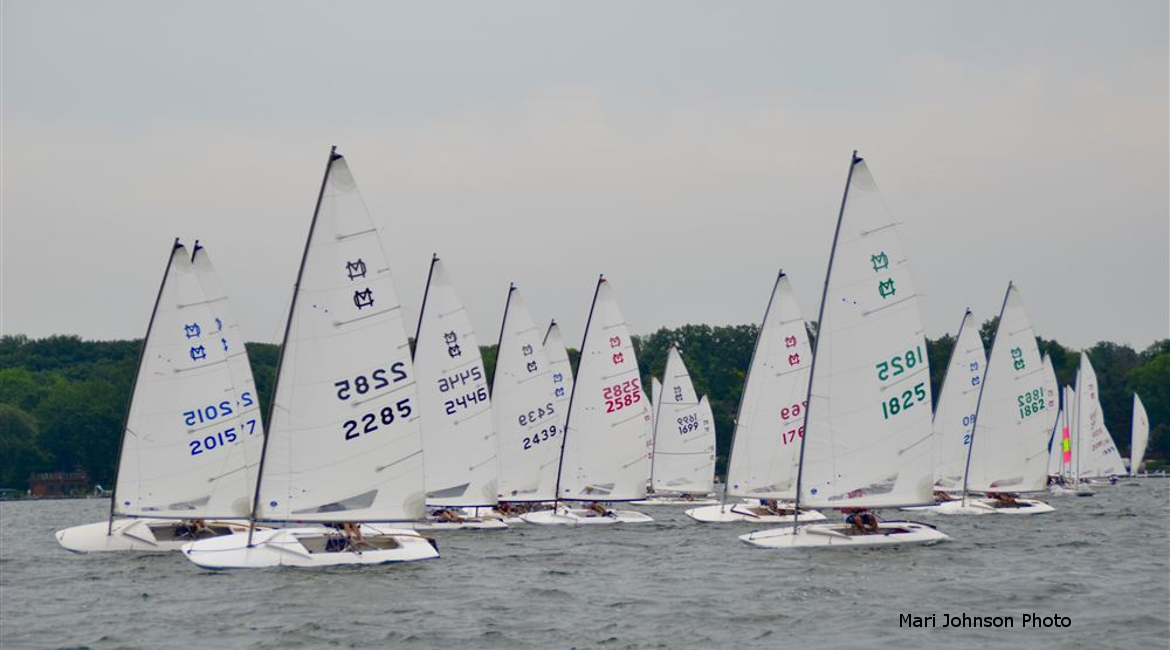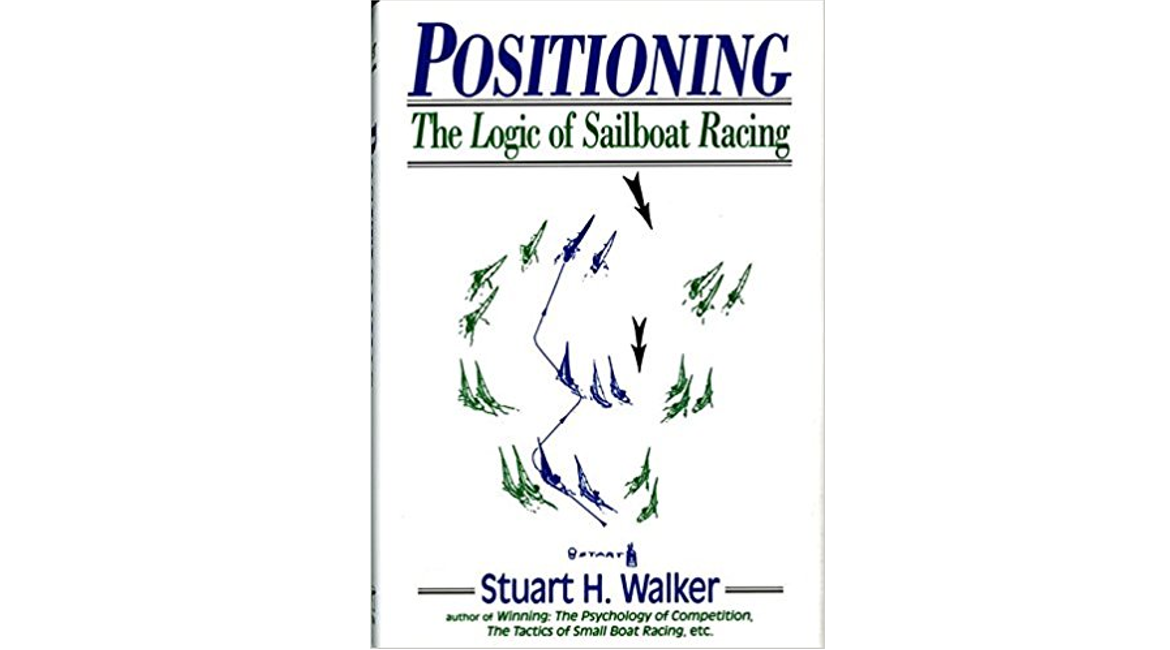It’s ten minutes before the start and you’re formulating strategy. Should you pick a favored side, or just sail the shifts and puffs and see what develops?
Most race courses, especially on lakes, will favor one side during at least one or more legs, so picking a side is often a good strategy. Notable exceptions are in a purely oscillating breeze or when the puffs and shifts are randomly distributed. See our posts on Sail the Lifted Tack and Connecting the Dots for discussion of these exceptions.
Unfortunately, it’s not easy to predict or observe the favored side, and the favor may change during a leg or from leg to leg. This makes strategy decisions difficult. How do you choose the favored side? How do you balance conservatism with winning the advantage? Does this choice depend on the wind conditions and the local eccentricities of the lake?
In this post, we review the advice for picking a side. There’s a wide variety of expert advice, but we have never run across a manageable approach to integrating it all. Stuart Walker’s books on strategy are comprehensive and well-organized, but are too dense for many sailor’s ambitions.
Stuart Walker’s Method
We believe that a simplified version of Walker’s approach gives you the best chance of making good decisions. Walker gives us decision factors to select from a few strategy choices. The decision factors include the physical conditions (weather, geography), your observations, and the race circumstances. You make your choice based on the reliability of the decision factors.
The more you understand about the decision factors, the better your choices will be. Thus, Walker has an extensive list of the physical conditions that cause one side to be favored, with comments on their reliability.
Our primary source for this article is Walker’s book, Positioning: The Logic of Sailboat Racing. We checked his advice against several other sources, as well as our own experience on inland lakes of varying sizes. Other sources include:
Setting Up Right for the Conditions, by Mike Ingham – Sailing World
Speed and Smarts Issue 71, by Dave Dellenbaugh
North U Performance Racing Tactics, by Bill Gladstone
Right or Left? How to Choose the Faster Side, by Gary Jobson – Sailing World
Sailing a Smart First Beat, by Steve Hunt – Sailing World
Decision Factors
In Make Better Decisions, we discussed the need to make high percentage decisions consistently. When deciding how to play the sides of a course, here are three factors to consider for a high percentage decision.
- Physical conditions: Are the wind, weather, and course conditions such that one side of the course is likely to be favored? How reliable are these conditions?
- Visible indications: Does one side appear to be consistently favored?
- Race circumstances: Is it early or late in the race? Are you satisfied with your position and regatta standing? Is the fleet large?
Three Favored Side Strategies
Pick a side and go all the way to the advantage
- Do this if:
- A favor to one side is visible and based on conditions that are reliable or clearly not transient. We discuss the reliability of various conditions later in this article.
- Execution:
- Start closest to the favored side.
- Don’t hesitate. Go all the way to the advantage at full speed, regardless of the heading needed to get there and the position of the fleet.
- Once you reach the advantage, stay on the favored side but sail more conservatively to protect your gain:
- Sail on lifts and tack on headers.
- Try to sail in localized ares of more wind.
- Cross others when you can to consolidate.
- Don’t let others cross you.
- Cover when ahead.
- Avoid the laylines early.
- Rationale:
- If one side has a major advantage, the first boat to reach it wins.
- Although these conditions are rare, if you can make one or two of these high percentage decisions in a series, you can boost your series score.
Pick a side, but hedge your bets
- Do this if:
- You think a condition that favors one side is reliable, but you can’t see it on the water.
- You can see a favored side, but aren’t sure if it is permanent.
- Most of the fleet (especially the top sailors) is going to a side.
- Execution
- Start on the side of the line closer to the favored side.
- Take the initial tack toward the favored side. If it’s not the lifted tack, use small headers and puffs to work your way to the side
- Work the shifts and puffs on the favored side, but stay closer to the center of the course than the other boats on that side.
- Rationale:
- With less certain conditions, it’s still wise to seek an advantage early in the race. If you make a gain, you can switch to a more conservative mode. If you lose ground, you still have time to make it up.
- Unless the wind is oscillating regularly or the puffs and shifts are totally random, picking either side is usually better staying in the middle, especially in big fleets.
Wait and see
- Do this if:
- You’re uncertain about the favored side.
- You can maintain clear air and get across the middle with some speed.
- Execution
- Start near the middle.
- After getting clear air and on the lifted tack, observe the progress of the fleet on both sides. Is one side winning? Is the reason visible?
- Make your decision and head for the side that’s winning.
- Concentrate on speed to get across quickly.
- Don’t change your mind and cross the middle twice.
- Rationale:
- This is a conservative move, that will limit your losses, but won’t likely put you in the front of the fleet.
- This is best accomplished early in the leg when the separation is minimal.
- You can also cross sides late in the leg when the course narrows back down.
Conditions Causing a Favored Side
Weather and geographic factors cause one side of the course to be favored. Some factors are more reliable in predicting a favored side than others. Here’s what the experts say.
Reliable conditions
Dying wind
According to Walker, a dying wind is a reliable predictor that one side will be favored. The dying wind is most often the end of a thermal breeze, late in the afternoon. Since the thermal breeze is caused by heated land, you must go to the edges of the course to catch what remains. Often this will be the side of the course nearest the shore.
Light air
Light air results from several causes: opposing thermal and gradient winds, lack of vertical mixing, or absence of both gradient and thermal winds. In all these cases, one side will likely be favored.
The principle rule in light air is to avoid the middle. There’s no reliable predictor for which side that might be. To make your choice:
- Scan constantly for new wind. Make sure it is coming your way before committing to it.
- If uncertain, go for the side of the course nearest the shore. See our post Light Air on Lakes: More Wind Near the Shore?
Developing thermal wind
If a thermal wind develops during the race, you can expect the thermal wind to be progressively veered; i.e., shifting right. This favors the right side of the course upwind.
This is not a common condition on lakes, especially on smaller lakes, where the surface area is not large enough to continually feed the thermal circulation. If it occurs, it will most likely be during the late morning and early afternoon. Check local knowledge to verify the reliability of thermal winds.
Geographic effects 1 – land contours and barriers
If the course is within 1/4 mile or so of land, the effects of contours and barriers are often reliable predictors of a favored side. Verify these effects with local knowledge or your own observation before relying on them.
- Wind parallel to shore tends to channel along the land contours. You can expect lifts or headers near places where the shore curves.
- Bays and openings along the shore. Depending on the distance from shore, you may be able to observe stronger wind or puffs from one direction near these features.
- High barriers. Tall obstacles on the windward shore may prevent the wind from reaching the surface. Their “shadow” extends into the lake anywhere from 10 – 30 times their height, depending speed of the wind and on the density of the barrier. Similarly, the wind will lift prior to reaching barriers on the leeward shore, creating a zone of calm.
Two winds – thermal and gradient
Since the thermal wind blows out from the center of the lake it will oppose the gradient wind in some locations and reinforce it in other locations.
- Expect a zone of calm where the two winds oppose, likely towards the windward shore.
- Expect stronger wind where the thermal wind and the gradient wind are blowing in the same direction, likely towards the leeward shore.
Current
Current usually favors one side. However, since current is not common on lakes, we’ll reserve that discussion for a future post.
Less reliable conditions
Weather system changes
Forecasted changes in the gradient wind are less reliable during the short time period of a single race. The forecasted change may occur earlier or later, and will not likely proceed smoothly.
However, you can get clues that forecasted changes are beginning if you monitor compass heading for out of range shifts or trends and look for obvious changes in clouds. If the race committee moves marks, that may be an indication that the wind is shifting progressively in one direction.
Rolls and Surges
In our post The Spectrum of the Wind, we discussed rolls and surges. Often, surges will make one side of the course favored on a given leg, especially on medium length courses. However, surges are not predictable and neither surges or rolls are useful for predicting a favored side.
Geographic effects 2 – lifts and headers as wind leaves shore
Many sailors have experienced favorable or unfavorable shifts on the side of the course near the shore. As the wind leaves the shore it changes direction because there is less friction over the water than the land.
Unfortunately, the experts do not agree on the reliability of this effect. Walker says this effect favors the right side if the course is near shore. Others say that the wind becomes more perpendicular to the shore on either side of the course. Here’s an interesting article summarizing the different claims, with some limited experimental evidence.
Waves
In heavy air, one portion of the course may be more sheltered from waves. This is hard to predict. However, it’s easily observed and may be worth considering as you plan your strategy.
Observations are Key
You’ll make the best decisions when you combine knowledge and experience with keen observation. That’s why you see top sailors looking up the course constantly.
- Before the regatta or race
- Get any available local knowledge.
- Review the forecast for the gradient wind.
- Review the potential for thermal wind.
- Before the start. For more, see our post on Pre-Race Routine.
- Divide the course into left, middle, and right; periodically scan for differences.
- Sail upwind and record headings before start – look for range, averages, and trends.
- If the course is near shore, look for geographic advantages.
- Classify the wind
- Puffy, shifty, steady?
- Random or regular changes?
- Thermal, gradient, or both?
- Do a two-boat test for favored side with a buddy.
- Determine if a favored side approach is warranted.
- During the race
- Shortly after the start, check how your plan is working. If needed, it’s better to change early.
- During the legs, keep track of the headings and compare them to your pre-race observations to spot trends.
- Keep your head out of boat – use all indicators.
- If the RC makes a mark change, be sure to evaluate the reasons.
Top Sailor Comments
This topic is among the most difficult for lake sailors. We wrote this article to make progress toward a manageable approach to decision-making. We’re sure we got some things wrong, so we will solicit comments from some of our favorite top sailors and update this post accordingly. Stay tuned!
SailZing posts on wind and upwind strategy





